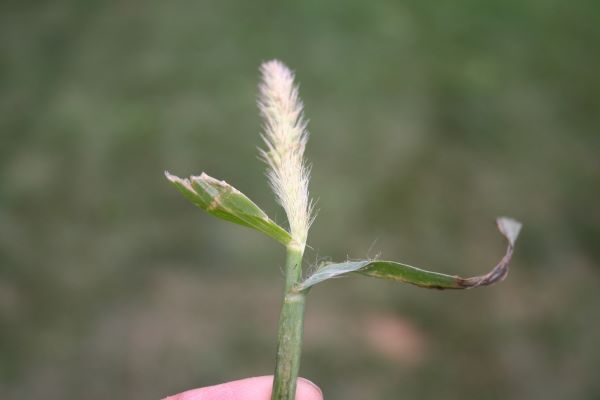Issue 10, August 26, 2021
Yellow Foxtail – A Warm-Season Weed in Cool-Season Turfgrass
Warm-season annual grassy weeds can be problematic in cool-season turfgrass. Common offenders include crabgrass, goosegrass, barnyardgrass, fall panicum, and foxtail. As a reminder, these plants live for only one year and their growth and development will be ending soon. A killing frost will control these weeds effectively. However, they are likely producing seeds now for next year’s weeds that will germinate in late spring or summer. Plan accordingly with your control tactics if this sounds like your situation. These weeds are particularly a problem in newly seeded areas in the spring as there is little competition, good growing conditions, and often an abundance of seed from these warm-season grassy weeds. Often too the presence of these weeds will indicate difficult growing conditions for the turfgrass.

Serious yellow foxtail infestation in a lawn. Michelle Wiesbrook. University of Illinois.
Yellow foxtail (Setaria pumila or S. glauca) is a common invader of turfgrass, while perhaps lesser known than crabgrass is. Like crabgrass, yellow foxtail is a prolific seed producer. Seeds germinate at temperatures between 68° and 95°F so germination occurs a little after that of crabgrass and can occur throughout the growing season. Yellow foxtail forms a coarse, upright or prostrate, bunch-type grass. It usually branches at the base and may root at the lower nodes. Growing up to 4 feet tall, yellow foxtail emerges from a shallow, fibrous root system and normally has flattened stems that are reddish near the base. The ligule is hairy, unlike that of crabgrass which is membranous. The leaves of yellow foxtail are flat, smooth, and with a prominent midvein. They grow 2 to 12 inches long and up to ½ inch wide. A key identifying characteristic of yellow foxtail is the long, wispy hairs that usually appear near the base on the upper surface. These are not found on similar but different species: green foxtail and giant foxtail. Giant foxtail has several very short hairs on the upper leaf surface while green foxtail lacks hair. The sheath is flattened and smooth. The flowers are yellow, cylindrical, dense, bristly, erect, and foxtail-like, growing 2 to 5 inches long. They appear from June through September. Yellow foxtail occurs in moist, fertile soil during the mid- to-late growing season and is often found in new seedings, open turf, or bare spots.

Yellow foxtail seedhead and long hairs at the leaf base. Michelle Wiesbrook. University of Illinois.
For control of foxtail species, be sure to maintain turf density and health through proper culture. Truly, this is the best form of weed control. Avoid close mowing and summer fertilization. Water deeply and infrequently to allow the soil surface to dry in between waterings. Core-cultivating, dethatching, and power raking should be conducted during the fall when cooler temperatures are conducive for good turf growth and weed seed germination is less likely to occur. With small populations, foxtail can be hand-pulled or mechanically removed. For large populations, a herbicide may be necessary. Apply preemergence herbicides 1 to 2 weeks prior to germination in the late spring or summer. Monitor soil temperature so that the herbicide is in place in time. A second application may be needed at a later date. Follow label directions for rates and timing. If overseeding or reseeding is in the plan for spring, a herbicide application for yellow foxtail could be detrimental to those efforts. Most preemergence herbicides have waiting periods between applications and seeding, but there are a few that can be applied at the time of seeding or soon after. Postemergent herbicides may be used but weeds should be small in order for control to be effective. This late in the season, I would advise you to scout now and if foxtail is found, focus your control tactics on preventing plants next year. When using any pesticide, read, understand, and follow the label directions for the safest, most efficient pest control.
Author:
Michelle Wiesbrook